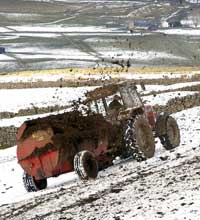Getting to grips with Nitrate Vulnerable Zones: Introduction

Farmers in England and Wales have a 70% chance of finding all or part of their farm in a Nitrate Vulnerable Zone, under the updated regulations which came into force on New Year’s Day.
| Key Dates 1 January 2009 New NVZ rules came into force in England, Wales and Scotland 31 January Deadline for farmers in England to appeal against their farm falling into an NVZ 31 March Deadline for farmers in Wales to appeal 30 April Farmers already in an NVZ need to have calculated their storage requirement 1 January 2010 Legislation comes into effect for farmers in new NVZs |
The new rules mean that most farmers will have to adapt their businesses to store animal manures for a considerable period of time and in conditions that comply with the new legislation. In many cases this will mean significant investment.
There are strict limits on the amount of nitrogen from livestock manure that farmers can store and spread, while there are similar restrictions on manufactured fertilisers and closed seasons when they must not be applied.
If all this sounds like it means more paperwork, that’s because it will. Farmers will need to request a DEFRA information pack which contains nine separate booklets. The information in these booklets is key to managing the use of nitrogen to stay within the law. Farmers can order their copy from the helpline number below.
What are NVZs?
Nitrate Vulnerable Zones exist to help Britain comply with the EU Nitrates Directive, which was voted into law to protect freshwater from nitrogen pollution. Agriculture is a “diffuse” source of nitrate pollution, which refers to the cumulative, day-to-day transfer of nitrates into watercourses. The Environment Agency estimates that agriculture accounts for up to 70% of nitrate pollution in surface water and more in groundwater.
Why is it a problem?
The European legislation is designed to protect drinking water. Nitrate pollution causes a process called eutrophication which extracts oxygen from water leaving barren, anaerobic conditions in which only algae can thrive.
What has changed?
The extended NVZ areas increase from 55% of England and Wales to cover nearly 70% of the country.
Agronomist Simon Draper, one of the experts helping to brief farmers on behalf of the EA, says it is imperative that farmers check whether all or part of their farm falls into an NVZ. “You need to check the location of boreholes and other surface water extraction locations, as well as river and other watercourses. It’s also important to remember that the new regulations are based on predictions that have been made for the future. You may be able to establish that nitrate run-off is below the 50mg/litre threshold now, but that may not be enough to challenge the regulations.”
But there are significant benefits to farmers who respond positively. “This is all about improving the efficiency of nitrogen use. The more efficiently Nitrogen is used, the more gets to the crop and isn’t wasted.”
| What help is available to farmers? Check whether all or part of your farm falls into an NVZ. The government’s MAGIC website allows you to check. www.magic.gov.uk select “Choose my own topic” and tick NVZ options. This is also the website used by cross-compliance and NVZ inspectors. Farmers in Scotland can check at http://tiny.cc/scotlandnvz Download the DEFRA guidance booklets and get free advice from the Momenta helpline on 0845 345 1302 |
The Livestock Manure N farm limit
Farmers must not now exceed a total of 170kg/ha of total nitrogen produced my livestock in each calendar year. This means farmers must work out the level of nitrogen in farm manures or slurries depending on the animal species, the numbers of animals and the time they spend on the holding.
Planning Nitrogen use
Farmers must also plan the spreading of nitrogen from animal manures and manufactured fertilisers to each crop in each field and stay within the new legal limits. This means farmers will have to calculate the level of available nitrogen already in the soil, the N requirement of the crop, the available N from planned spreading of livestock manures and calculate the remaining level of manufactured nitrogen they can apply. Accurate record keeping is also a requirement.
The NMAX Calculation
For each crop, farmers must ensure their application of crop available nitrogen from livestock manure and manufactured fertiliser does not exceed the maximum legal application rate (NMAX) for the crop type. Farmers will also have to demonstrate they have done this and record the amount of nitrogen actually spread at each application.
Closed spreading periods
Farmers must also observe closed periods on the spreading of some manures on grassland and tillage land. Closed periods also apply for manufactured nitrogen fertiliser. There are also rules on storage and application techniques.
Back to front page of guide
